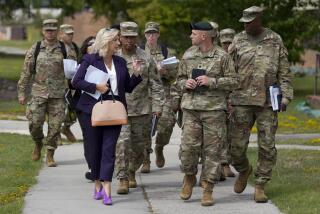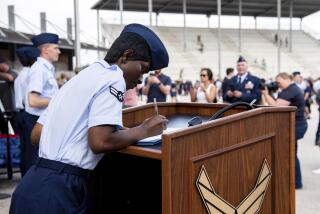Military Haunted by a Paper Tiger : Defense: Warnings are raised of a return to the ‘hollow force’ of the 1970s. The coffers are full now, but some see readiness slipping under Clinton.
- Share via
WASHINGTON — Robert W. Gaskin was a young Air Force pilot during the early 1970s when he saw something he would never forget.
On a ramp at Davis-Monthan Air Force Base in Arizona were row upon row of freshly painted A-7 fighter aircraft. “But if you looked through their intakes, you could see daylight coming from their tailpipes. None of them had any engines inside,” Gaskin recalled. “They’d all been cannibalized for spare parts, and there was no money around to replace them. It was the perfect example of the ‘hollow force.’ ”
To anyone concerned about America’s military preparedness, such memories are unsettling. During the post-Vietnam War drawdown of the 1970s, the U.S. armed forces showed abundant supplies of personnel and equipment--on paper. But because of the budget crunch, thousands of manpower slots went unfilled, the troops were not well-trained, the military’s rapidly aging equipment was not properly maintained, and parts and ammunition were in short supply.
Coining a phrase that later was to become the catchword for such conditions, Gen. Edward C. Meyer, former Army chief of staff, later complained in disgust about the plummeting readiness and branded the military of the 1970s “the hollow force.” Even though the services rebounded during the military buildup of the mid-1980s, the label lingered to haunt Congress and successive administrations.
It may seem far-fetched to raise such specters again in 1993. Today’s armed forces still enjoy the largess from the flood of defense dollars lavished by the Ronald Reagan Administration. U.S. forces turned in a near-textbook performance during Operation Desert Storm in 1991. And almost daily, both military and civilian leaders are praising the U.S. armed forces--without hyperbole--as the best in the world.
One analyst, Paul E. Taibl, a former Air Force officer who is research director of the Defense Budget Project, believes that a scenario like the one Meyer described is highly unlikely any time soon. “The Pentagon’s coffers are more than full,” he contends.
But to Gaskin, now a retired colonel and defense analyst, and other experts, visions of the 1970s are returning as the military’s rapidly shrinking budget begins to sap funds for training, maintenance and recruiting, which are essential for readiness. Adding to the budget squeeze are growing spending needs for everything from peacekeeping operations in places like Somalia to replacement of aging fighter aircraft with higher-tech models.
The readiness issue could pose a serious political problem for President Clinton, who already is straining to overcome an anti-military image and the perception that he is not savvy enough about national defense needs.
Former President Jimmy Carter, who was commander in chief during the “hollow forces” days, still has not lived down the blame for the plunge in readiness back then. And Carter was a one-time naval officer, without Clinton’s draft-related problems.
The Clinton Administration, aware of the sensitive nature of the issue, has pledged to maintain readiness levels. Defense Secretary Les Aspin has asked Congress to increase funds for operations and maintenance by 1%, despite the sharp 5% reduction in overall defense spending, and has asked for $380 million more to help finance U.S. participation in U.N. peacekeeping activities.
He also has begun a “bottom-up review” of the defense budget in an effort to deal with longer-term problems, including the oversized military infrastructure--such as unneeded bases and supply depots--which is siphoning money that otherwise might be spent for readiness.
Last month, in a largely symbolic political gesture to the military, Aspin appointed a special eight-member panel of retired generals and admirals--conspicuously headed by former Gen. Meyer--designed to serve as a watchdog against erosion in readiness. And in a speech earlier this month, Aspin pledged anew that the Administration would guard against any slippage in readiness. “We will not let that happen,” the secretary vowed.
But some analysts say they already see warning signs that readiness levels are beginning to slip from their highs of 1991 and 1992:
* Partly because of budgetary shortfalls, the services have had to postpone long-term maintenance of equipment to help finance current operations. The Navy, for example, has some 150 warplanes, 250 aircraft engines and three ships overdue for regular overhauls. The Army has more than 1,000 tanks awaiting repair and is delaying the shipment of automatic weapons, pistols, rifles, missiles and ammunition. The Marine Corps is behind on tank maintenance.
* The quality of recruits has begun to slip--albeit only slightly--with proportionally fewer high school graduates than the services were able to attract even a few years ago. Aspin recently reported that 94% of the young men and women who are joining the military services today have high school diplomas, compared with 97% two years ago. And 70% are scoring in the upper half of the armed forces entrance test--down from 75% in 1991.
* Both the Air Force and Marines have had to cancel some combat training exercises in order to help finance day-to-day military operations in Bosnia, Somalia and other trouble spots. “World events and economic considerations have added even more urgency and impetus to redirecting some of our energies,” said Navy Vice Adm. Edward Straw, director of the Defense Logistics Agency.
And last week, Aspin stunned lawmakers and military officers alike by warning that unless Congress reworks the restrictions that it has placed on defense spending, the military services will have to slash as much as $20 billion more from the fiscal 1994 Pentagon budget just to stay within congressional guidelines--a sum that almost certainly would come out of readiness programs. The services already are preparing contingency plans to carry that out.
Gen. Walter E. Boomer, assistant commandant of the Marine Corps, concedes that so far, the danger signs are modest. But he warns that unless they are heeded, the situation three years from now could be serious. “As I go around to our various bases and ‘kick the tires,’ I find that our readiness is still OK. But as I look out to future years, I have some real concerns.”
Don M. Snider, a military analyst at the Center for Strategic and International Studies, agrees. Snider frets that the first serious signs of slippage may not be that far away. “I am concerned about hollowness, and I think that we’re soon going to be able to document some,” he said. “My personal judgment is that the Administration has a year” to act before readiness begins to slip.
The concerns stem from several factors:
* The reductions in the size of the military over the past eight years have pared the Pentagon’s operating budget sharply--about to the edge of what is needed to sustain the current force. But the Defense Department has not kept pace in cutting back expensive overhead, such as unneeded military bases and supply depots, which are eating up larger and larger shares of the remaining money. All sides agree that must be reversed soon.
* The military has racked up substantial bills for “peacekeeping” operations in various trouble spots, much of which will have to be absorbed within current budget levels. Prior to this weekend’s military action in Somalia, for example, sources had estimated that the U.S.-led “rescue” there would cost almost $1 billion. And American aircraft are conducting what amounts to combat operations by enforcing “no-fly” zones over Iraq and Bosnia. U.S. action in Serbia could cost several billion dollars more.
* Although exact figures are unavailable, the Pentagon faces sizable outlays over the next few years for everything from providing medical care--whose cost in the civilian economy is skyrocketing--to replacing aging combat aircraft and modernizing equipment ranging from amphibious vehicles to Aegis cruisers. Analysts point out that even though tomorrow’s military will be smaller, it will take more money per soldier to equip it with the high-tech weapons needed to keep it as effective.
* The military is facing myriad social changes that some analysts fear could spawn morale problems and ultimately affect readiness as well. Service personnel already are worried about the impact of the military cutbacks on their own futures. But the armed forces also are expanding the role of women in combat posts and most likely will ease the current ban on homosexuals. All represent changes--and adjustments--from the traditional military ways.
* Congress, eager to rechannel defense dollars into domestic programs, is pushing for still-further reductions in the military budget. Although the betting is that this year lawmakers will end up passing Clinton’s $263-billion fiscal 1994 defense budget intact, some analysts believe there will be increasing pressures to trim more in coming years--particularly as the military gets smaller.
The Defense Budget Project’s Taibl worries that if lawmakers make further cuts, they will be more likely to slash the military’s operating budget--which provides the bulk of the monies needed to ensure readiness--than to pare funding for development and construction of weapons, which often provides jobs and spending that is important to members of Congress for political reasons.
“Congress will be the first ones to call for a high readiness rate,” Taibl said, “but the (operating) budget will be the first to be cut.”
The nation’s top military leaders already have begun to sound the alarm, warning during a congressional hearing last month that cutting the budget any more sharply could seriously threaten military preparedness.
“In the case of the Army, we are on the razor’s edge,” said Gen. Gordon R. Sullivan, the Army chief of staff. The chief of naval operations, Adm. Frank B. Kelso, agreed. “We’re on the ragged edge in readiness,” he said.
Analysts concede that calculating readiness is a complex affair. The military already has an early warning formula that tracks such figures as the number of hours that the armed forces train, the number of hours that their aircraft and ships are underway and the maintenance schedules for major equipment. The amount of money available in the services’ operations and maintenance accounts also is an often-cited indicator. All are in relatively good shape.
But as Aspin points out, the figures don’t always tell the full story. The number of flying hours for aircraft, for example, includes such items as airlift missions to Somalia, which contribute only marginally to readiness levels. And anecdotal evidence, frequently an early danger sign, is difficult to compile service-wide.
But Dov Zakheim, a defense analyst with System Planning Corp. in Arlington, Va., warns that the going won’t be easy. “Unless Aspin and the Administration can deliver on every single promise they made, they will confront a hollow military whether they like it or not,” he said. “It probably won’t come in (Clinton’s) first term, but whenever it comes, it will be this Administration’s legacy.”
Gaskin, now a military analyst for Business Executives for National Security, another defense research group, agrees. “It takes five or six years to get yourself into this kind of predicament, and by my judgment we’re in Year One already. If we let ourselves get into that kind of mess, it would have to be followed by another Reagan-style buildup--and we can’t afford that. We really have to start paying attention to it right now.”
More to Read
Get the L.A. Times Politics newsletter
Deeply reported insights into legislation, politics and policy from Sacramento, Washington and beyond. In your inbox three times per week.
You may occasionally receive promotional content from the Los Angeles Times.










